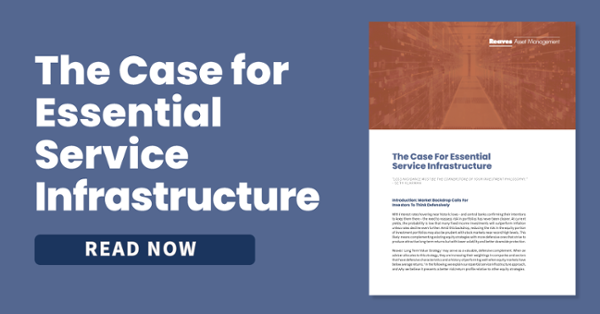U.S. railroads have existed for 200 years, yet the competitive moats around the business remain intact and, in our view, the investment case remains compelling. In this Q&A, Reaves’ Chief Investment Officer, Tim Porter, shares his view on the industry, and what the future holds for it.
What characteristics do rail stocks have that make them attractive investments?
Tim Porter: Like most stocks in our investment universe, railroad companies are true, mission-critical infrastructure businesses, the likes of which, we believe, cannot be replicated. There’s a degree of economic cyclicality to railroad volumes, but at the end of the day, goods and raw materials have to be transported, and there’s no way to do that better than rail. Railroad delivery avoids the unpredictability of congestion associated with truck transport. It is also more environmentally friendly than transporting goods via trucks, ships or air.
On average, railroad stocks advanced by about 23% in 2021.1 How do you gauge valuations today?
Tim Porter: Historically, railroads have traded at a slight discount to the S&P 500 Index, and currently, they are in line with the broader market.2 This is because the industry has become more profitable and has improved return on invested capital. The advent of precision scheduled railroading (PSR) has made railway transportation far more efficient. Through PSR, trains operate on a fixed schedule, rather than leaving a station once a train has a sufficient number of loaded cars. PSR also simplified routes, with more direct routes to larger stations and fewer transfers at smaller transfer stations.
The changes translated to more reliable service, and with increased reliability, more businesses as customers.
PSR has also led to operational efficiencies, including less fuel, fewer workers and the closing of smaller transfer stations. In turn, we have seen substantial earnings and cash flow growth across the industry. Going forward, we continue to see potential for growth as companies aim to generate more free cashflow, buy back stock and compound earnings per share at an attractive rate.
What role does management play in your analysis of the sector?
Tim Porter: More than in many other industries, management’s strategy plays a big role in the success or failure of a company. And we’ve seen a divergence between those companies that are well managed and not. Former industry executive, Hunter Harrison, is widely credited for the advent of PSR. Many of his proteges are still leading or advising other railroad firms. Some of those executives have had a big influence in making select companies more profitable.
Kansas City Southern is in the process of merging with Canadian Pacific. Can you update us on that transaction and offer any thoughts on further M&A?
Tim Porter: We think it’s likely the deal gets approved, but we don’t expect further consolidation due in large part to antitrust concerns. Some of these railroad networks now connect three different countries, so any additional mergers would represent a significant geographic footprint that could draw anti-competitive concerns from regulators.
Reaves published a prior blog about improving operating ratios. Is there more room for improvement?
Tim Porter: Yes. While PSR has already improved operating ratios there is still potential for improved logistics technology to help create longer train links, which makes transportation more fuel efficient. The industry could still reduce dwell times at rail yards. Finally, technology is allowing for automated track and car inspections. Eventually, we could see technology improvements make trains operable with only one engineer versus the required two engineers per train now.



